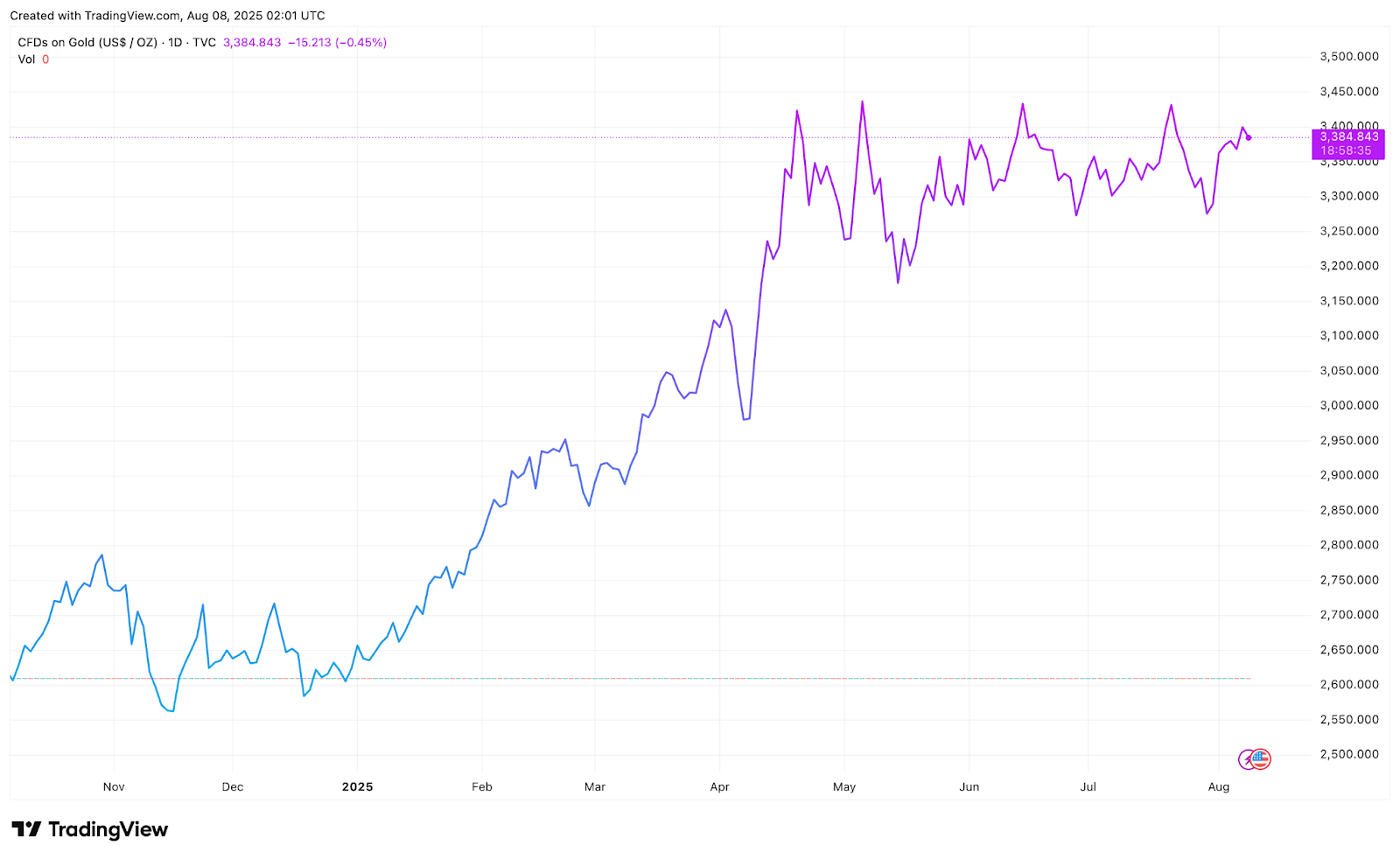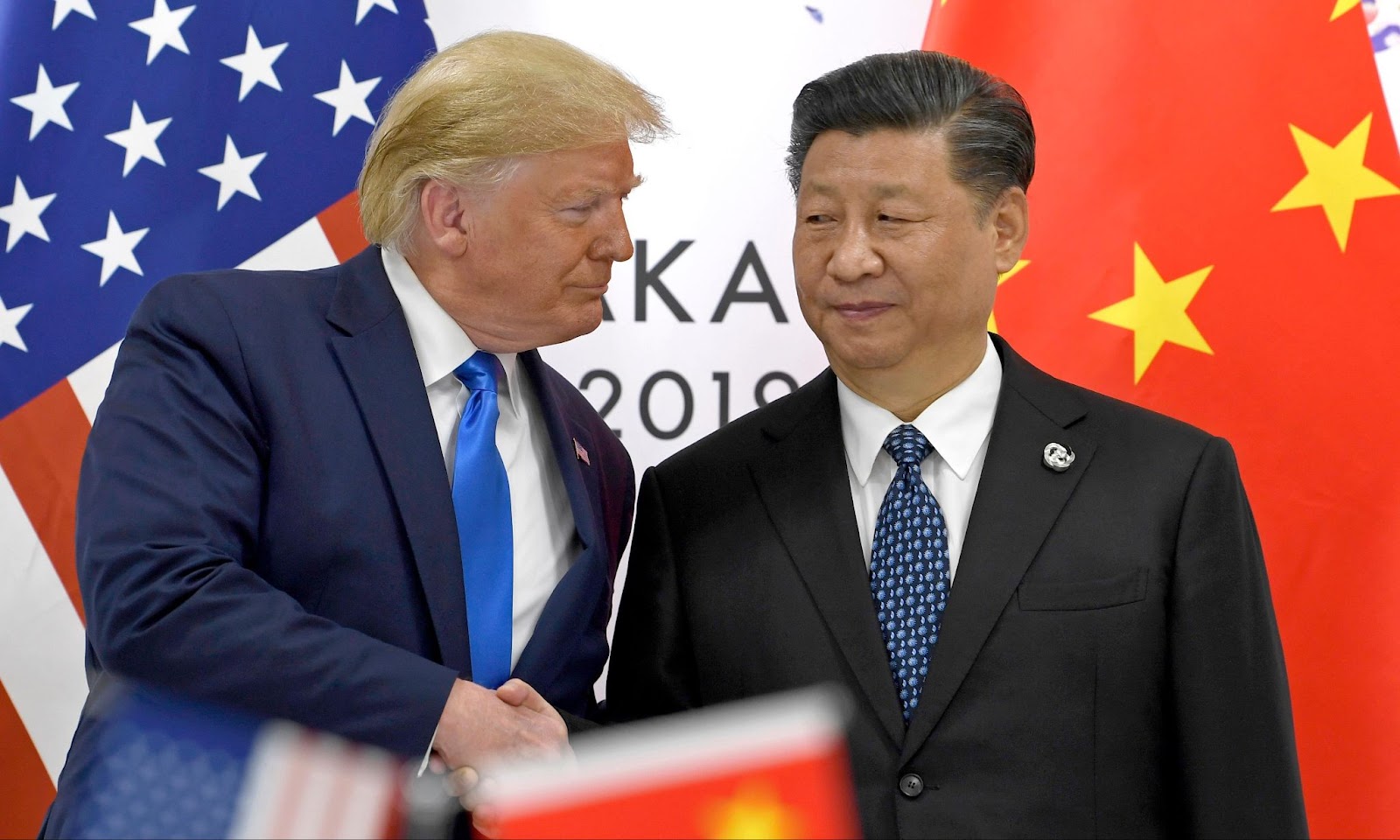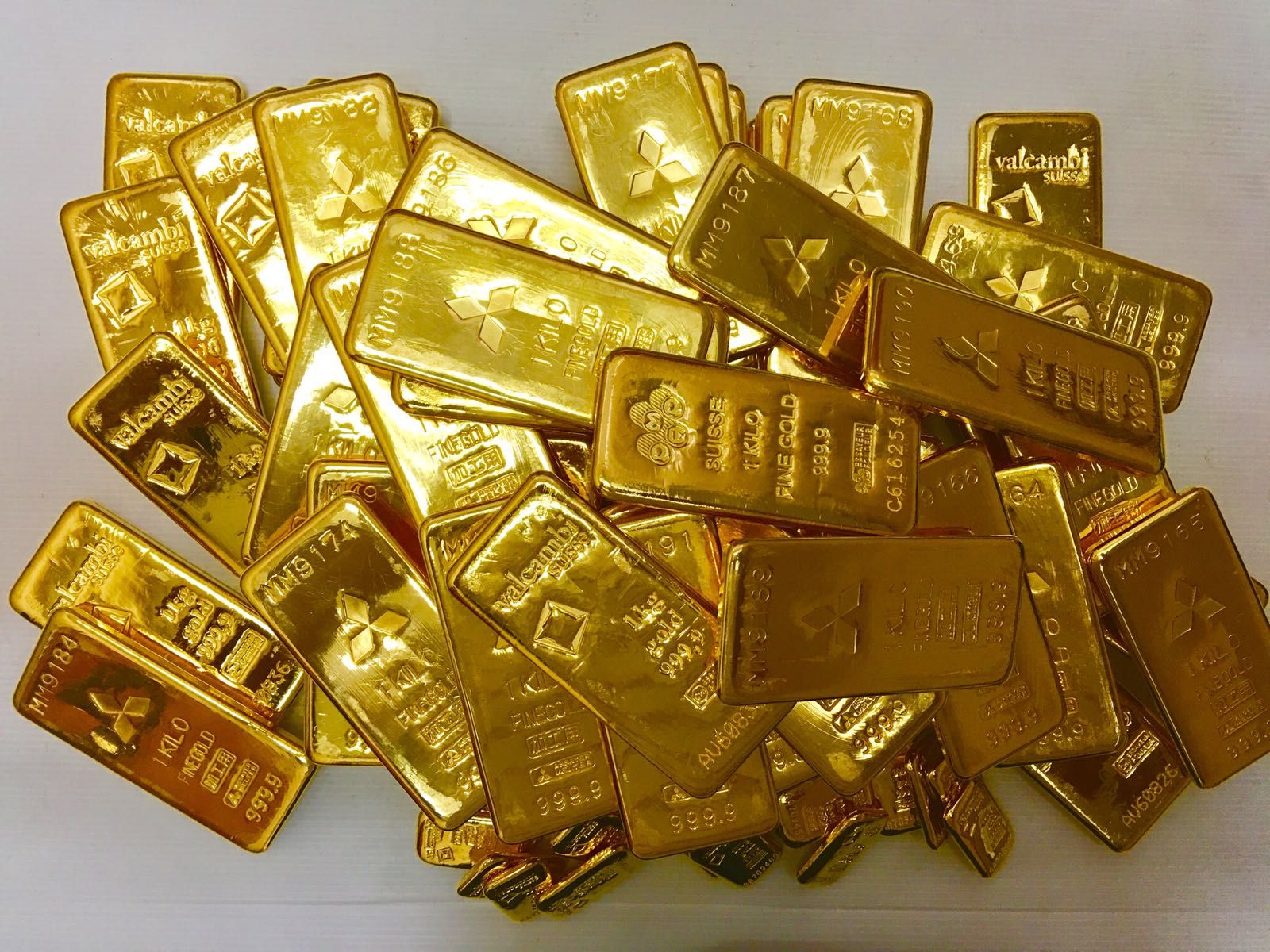By David J Mitchell, Managing Director, Indigo Precious Metals
The Catalyst Analysis: Forces Poised to Drive Gold Beyond $4,000
Gold price forecast 2025 has become a central focus for investors worldwide as the yellow metal navigates through what has been an extraordinary period of consolidation from the late summer of 2020 into finally breaking higher in March of 2024. After reaching a historic high of $3,500 in April 2025 followed by a sharp -11% correction into May 2025, gold has settled once again into a pennant consolidation phase that many analysts believe is merely a pause before the next significant move upward.
At Indigo Precious Metals, we have been tracking this consolidation pattern with keen interest, particularly as it follows an impressive 29% year-to-date gain as of 8th August 2025, that has outpaced our earlier projections. The critical question now facing investors is not whether gold will break out of this consolidation, but what specific catalysts will trigger the next move—and how dramatic that move might be.
Image: Tradingview.com, prices as of Aug 08, 2025, 02:01 UTC
Understanding Gold’s 3-Year Consolidation Pattern
The current consolidation phase must be viewed within its historical context. Gold has demonstrated a consistent pattern of prolonged sideways trading followed by explosive breakouts. The consolidation that began in 2020 and has continued through and into early 2024 represents one of the most significant bases in gold’s recent history, creating a solid foundation for what many analysts predict will be a substantial upward move.
From a technical perspective, the consolidation has formed a classic ascending triangle or indeed a pennant pattern with a horizontal resistance level near $3,450 and a rising trendline alongside horizontal support at $3,260 providing support. This formation is typically bullish and represents accumulation over time, with each dip creating higher lows—a signal of growing bullish pressure beneath the surface. Gold does not top-out with quiet sideways lateral price action.
What makes the current consolidation particularly noteworthy is that it has occurred despite extraordinary global circumstances that would typically drive gold prices higher: heightened geopolitical tensions, trade wars, and concerns about fiscal sustainability in major economies. This suggests that once the consolidation breaks—which appears increasingly imminent—the resulting move could be dramatic.
For those looking to position themselves ahead of this anticipated breakout, our investment precious metals offerings provide a secure entry point into physical gold ownership.
Major Institutional Forecasts: Goldman Sachs and JP Morgan
Leading financial institutions have recently revised their gold price projections upward, reflecting growing confidence in gold’s prospects for late 2025 and beyond.
Goldman Sachs: Structural Support from Central Banks
Goldman Sachs has significantly raised its year-end 2025 gold price forecast to $3,700 per ounce, up from their previous projection of $3,300. Their analysis points to a projected range between $3,650 and $3,950, driven primarily by stronger-than-expected demand from central banks and heightened exchange-traded fund (ETF) inflows as investors position for potential recession risks.
The investment bank has identified central bank purchases as a critical factor, revising their central bank demand assumption upward to 80 metric tons per month. Their analysis suggests that “structurally higher central bank demand will add 9% to the gold price by year-end,” which, combined with increasing ETF holdings as interest rates decline, creates a powerful upward pressure on prices.
In more extreme scenarios—particularly if global economic uncertainty intensifies or recession materialises—Goldman Sachs suggests gold could approach $4,500 per ounce by the end of 2025.
JP Morgan: The Path to $4,000
JP Morgan has provided an even more bullish outlook, projecting that gold prices will average $3,675 per ounce by the fourth quarter of 2025 and cross the psychologically important $4,000 threshold by the second quarter of 2026.
The bank cites “tariff-driven recession and stagflation risks” as key factors that will “continue to supercharge gold’s structural bull run”. This forecast is built on projected continued strong demand from both investors and central banks, averaging approximately 710 tonnes per quarter on a net basis.
JP Morgan’s sensitivity model provides valuable insight into the mechanics of price movement, indicating that “every 100 tonnes of quarterly increase in holdings from investors and central banks is worth around a 2% quarterly increase in the price of gold”. With a breakeven demand level (for prices to stay flat quarter-over-quarter) of around 350 tonnes, the projected 710 tonnes of quarterly demand suggests significant upward price pressure.
For those seeking to capitalise on these projections, our gold bullion products offer direct exposure to physical gold with the security and provenance that sophisticated investors demand.
Five Catalysts That Could Break the Consolidation
While technical patterns and institutional forecasts provide a framework for understanding gold’s potential trajectory, specific catalysts will ultimately trigger the breakout from consolidation. Five factors stand out as the most likely drivers:
1. Accelerated Central Bank Buying
Central bank gold purchases have remained a consistent source of demand, with global banks acquiring over 1,000 tonnes annually for three consecutive years. This trend shows no signs of abating, with China’s central bank alone adding 95 tonnes in Q1 2025.
The motivation behind this central bank accumulation is strategic diversification away from US dollar reserves, a trend that has accelerated as geopolitical tensions have intensified. JP Morgan’s analysis suggests that central bank purchases will reach approximately 900 tonnes in 2025, continuing to provide structural support for prices.
Our allocated storage service offers investors the same level of security and sovereignty that central banks seek when accumulating gold reserves.
2. Recession and Stagflation Risks
The spectre of recession, particularly one driven by tariffs and trade tensions, looms large over global markets. Should economic data continue to deteriorate, gold would likely benefit substantially as investors seek safe-haven assets.
Of particular concern is the potential for stagflation—a toxic combination of economic stagnation and persistent inflation that historically has been highly supportive of gold prices. JP Morgan specifically cites “tariff-driven recession and stagflation risks” as key factors that will “continue to supercharge gold’s structural bull run”.
3. Dollar Weakness and Currency Concerns
The US Dollar Index (DXY) fell to 94.2 in April 2025, its lowest level since 2021, establishing a clear inverse correlation with gold’s ascent. This currency weakness reflects growing skepticism about centralised monetary systems and has directly contributed to gold’s appeal.
With concerns about US fiscal sustainability intensifying, further dollar weakness appears likely—creating an environment highly conducive to higher gold prices. Goldman Sachs specifically notes that if “concerns over US fiscal sustainability escalate,” gold could rise an extra 5% to $4,250 per ounce by December 2025.
4. Geopolitical Tensions
Ongoing conflicts, including situations in Ukraine and the Middle East, combined with intensifying US-China trade frictions, have created a heightened state of global uncertainty. The World Gold Council identifies “safe haven” demand driven by geopolitical tensions as a key bullish catalyst for gold.
These tensions not only drive direct investment demand but also encourage central banks to accelerate their diversification away from US dollar reserves—creating a powerful dual support mechanism for gold prices.
Image: US President Donald Trump and China President, Xi Jinping
5. ETF Inflows and Investment Demand
After a period of outflows, gold ETFs have begun to see renewed interest, particularly in Asia. Goldman Sachs projects “a gradual boost to ETF holdings as the funds rate declines,” which should combine with central bank demand to drive prices higher.
Singapore specifically has seen strong growth in gold investment, with bar and coin demand rising by 22% year-on-year in 2024. This trend is expected to continue through 2025 as economic and geopolitical uncertainties persist.
For Singapore investors looking to participate in this market, our Singapore bullion dealer services provide expert guidance tailored to the local regulatory and market environment.
Singapore’s Gold Investment Landscape in 2025
Singapore has emerged as a key player in the global gold market, becoming one of Southeast Asia’s top gold holders. The city-state saw gold investment surge by 22% in 2024, with bar and coin demand rising, as investors increasingly turned to gold as a safe-haven asset.
The Monetary Authority of Singapore has made strategic adjustments to its gold reserves, maintaining significant holdings.
For Singapore investors, gold price prediction Singapore remains highly favourable for 2025, with local analysts projecting continued strong demand, particularly in the investment segment. The JP Morgan reports that analysts expect gold prices to range between US$3,500 and US$3,700 per ounce over the third and fourth quarters of 2025.
Our gold investment solutions are tailored to meet the needs of Singapore investors seeking to capitalise on these favourable market conditions.
Frequently Asked Questions
What is the gold price forecast for the end of 2025?
Major financial institutions have revised their forecasts upward, with Goldman Sachs projecting $3,700 per ounce and JP Morgan expecting gold to average $3,675 per ounce by Q4 2025. Some analysts suggest that in certain scenarios, particularly if recession materialises, prices could approach or exceed $4,000 per ounce.
Why has gold been in a consolidation phase?
Gold’s recent consolidation follows a dramatic surge to $3,500 per ounce in April 2025. This consolidation represents a healthy market adjustment after an extended rally, allowing overbought conditions to ease without compromising the overall bullish trend. Such consolidation phases typically precede the next significant move in the gold market.
What role are central banks playing in the gold market?
Central banks have been net buyers of gold since 2010, with purchases exceeding 1,000 tonnes annually for three consecutive years. This trend is expected to continue, with projections of 900 tonnes of central bank buying in 2025. This persistent demand provides structural support to gold prices and reflects a strategic move by central banks to diversify away from US dollar reserves.
How will a potential recession impact gold prices?
Historically, gold has performed strongly during recessions as investors seek safe-haven assets. Both Goldman Sachs and JP Morgan suggest that a recession scenario would lead to accelerated ETF inflows and significantly higher gold prices, potentially pushing toward $4,000 per ounce or beyond.
What makes Singapore an attractive market for gold investment?
Singapore offers a favourable regulatory environment for gold investment, including GST exemption for Investment Precious Metals (IPM). The city-state’s strong financial infrastructure, world-class storage facilities, and strategic location in Asia make it an ideal hub for precious metals investment. Additionally, Singapore has seen robust growth in gold investment demand, with a 22% increase in 2024.
Will gold prices decrease in the coming days and weeks?
While short-term fluctuations are always possible, the structural factors supporting gold—including central bank buying, geopolitical tensions, and recession concerns—suggest that any near-term weakness would likely represent a buying opportunity rather than the beginning of a sustained downtrend. Most major institutions maintain bullish forecasts for the remainder of 2025.
The Path Forward: Beyond Consolidation
As we navigate through the remainder of 2025, the gold market stands at a critical juncture. The three-year consolidation pattern has created a solid foundation for the next move, while a confluence of supportive factors—from central bank buying to geopolitical tensions—suggests that the breakout will be to the upside.
For investors, particularly those in Singapore, this environment presents a compelling opportunity to establish or increase physical gold holdings before the consolidation definitively breaks. The combination of strong local demand, favourable regulatory conditions, and positive price projections creates an ideal environment for strategic gold investment.
At Indigo Precious Metals, we remain committed to providing our clients with the insights, products, and services needed to navigate this dynamic market successfully. Whether through direct ownership of gold bullion, participation in our bullion gram savings plan, or utilisation of our secure allocated storage service, we offer comprehensive solutions tailored to your investment objectives.
The question is no longer whether gold will break out of its recent consolidation, but when—and how dramatically. By positioning now, investors can potentially benefit from what many analysts project will be gold’s next significant move upward, potentially toward the $4,000 threshold and beyond.
Position your portfolio for resilience. Learn why gold continues to be deeply undervalued in 2025. Explore the full analysis.




